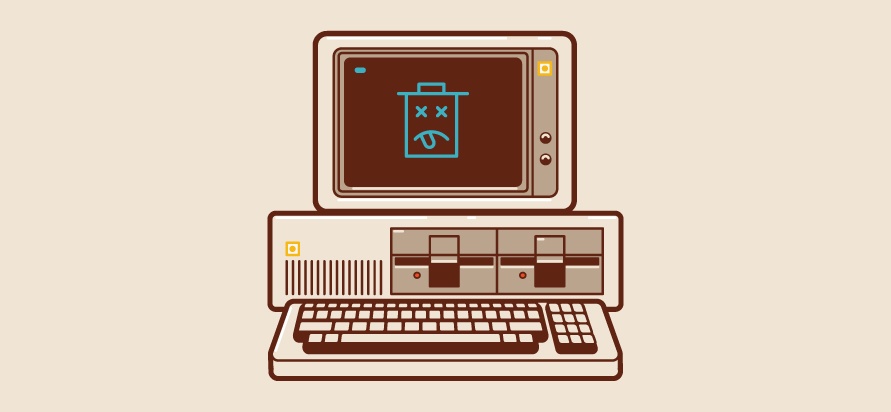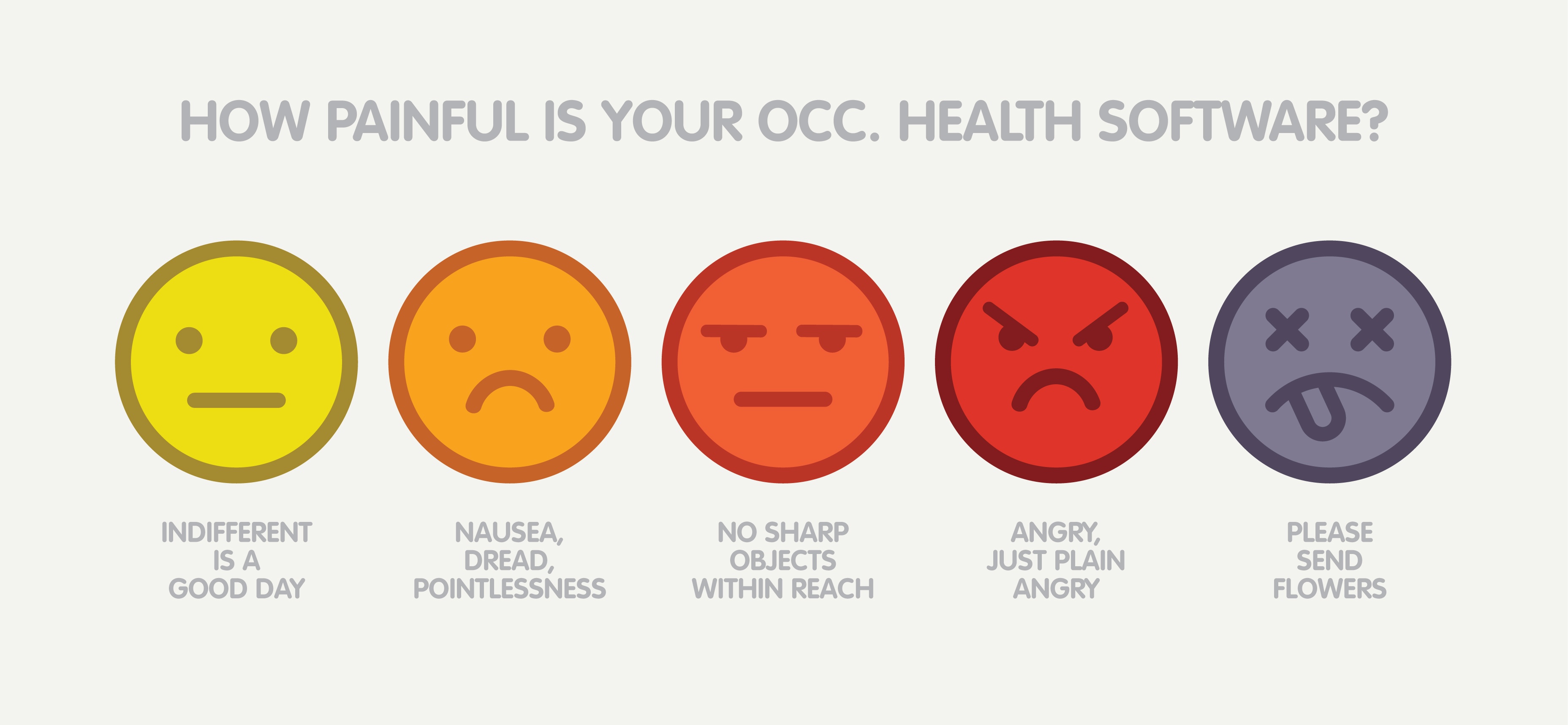Your occupational health IT solution isn't just legacy...it's lousy
By Enterprise Health on Apr 20, 2017 1:44:07 PM

On-screen garbage: a cautionary tale — part 1 of 3
This post is a recent conversation between Enterprise Health president, Jeff Donnell, and CTO, Dave Juntgen, following a visit to a new client. It begins a three-part series.
Jeff: Dave, you and I recently had the opportunity to spend three days on site with a new client. We conducted an in-depth discovery session and defined the project scope with the aim of deploying our occupational health and compliance solution to replace a competing commercial application that was not meeting this customer’s needs.
Dave: That’s the understatement of the century. One of the client contacts called the legacy application “a piece of garbage they hung on a screen.” After seeing this thing in action, I think she was being kind.
Jeff: That’s true, but the intention of this post is not to bash a competitor, so we won’t name any names. But let’s face it, this particular employer organization has complex requirements to match a demanding operating environment. Supporting the occupational health IT needs of this client is not for the faint of heart or the poorly equipped.
Dave: I’ll stay on the high road with you, but let’s shed some light on just how challenging it is for employers to manage occupational health and compliance using some of the toolsets currently deployed in the market.
Jeff: Roger that. As I recall, our first inkling of trouble was when the client project manager explained that the incumbent vendor was not able to customize their solution per the agreed upon schedule — so the implemented solution actually added work. They expected an adjustment period as they transitioned to a new system, but they also expected gains in productivity and efficiency.
Dave: And they got neither. Their exact quote was, “It does nothing for you.” In fact, they estimated every encounter now takes an extra 20 minutes to document. They also described click fatigue, telling us “it takes 12 clicks to print a surveillance encounter.”
Jeff: I think Chronic Click Fatigue Syndrome should have its own ICD-10 code. The most amazing thing to me was that they invested heavily in this electronic solution (and I use the word solution loosely) and determined it was not capable of serving as their legal medical record. So they actually document encounters in this application AND have to maintain paper charts! It sounds like the worst of both worlds.
Dave: That blew my mind as well. That's why at the heart of Enterprise Health is an ONC-ACB certified electronic health record, which means they can phase out those paper records and duplicative documentation.
Jeff: After hearing about all this during our kick-off meeting, you and I had the same reaction.
Dave: Yep — we had to see this monstrosity in action. It’s one thing to hear about it, but seeing is believing.
Jeff: I saw it, and I still can't believe it. We sat down with the clinic director (who is a physician) and the physician assistant. There were two screens on the desk, and they walked us through all the steps necessary to document an encounter. The first thing that struck me was the antiquated user interface.
Dave: It looked like a basic spreadsheet with buttons and tabular data from 20 years ago. Data entry screens were designed without the end user in mind, and they were not exaggerating the number of clicks required. When they went from one section of the electronic chart to another, they had to close the section they were in, then open another section, then close that section to go back.
Jeff: When they showed us the clearance exam, they had to click on every clearance item individually. And when conducting the exam, there was no place to click on “all normal”, so they had to click on every individual exam component. There was very little intelligence built into this system.
Dave: Which makes me question the intelligence of the people who built it. How about the medications section? There was no intelligent auto-complete capability, so they had to type in the full name of every drug. On top of that, there were multiple instances where they had to enter the same information over and over. No enter it once and have it propagate across the solution like we do. At one point, the PA was entering the exact same information on two different screens.
Jeff: The worst part came at the end of the process. They had to print five different paper reports: for the paper chart they have to maintain, for the patient, for the supervisor, etc. This electronic application is killing an acre of trees each week. And it took 15 minutes to create and print the reports, so the patient has to wait rather than head back to work.
Dave: That was hard to comprehend. At least in our solution, if you need to print something at the end of the encounter, we automatically create all the documents and you click print — and everything you need is generated. In this crazy solution, it took a multitude of clicks for each report, and they had to open a separate report writing application to do it.
Jeff: The icing on the cake is the limitations of this bad boy forced them to deploy a host of custom applications and home-grown databases designed to do all the things their commercial system is incapable of handling.
Dave: When they shared the diagram that depicted all those applications and the interfaces they had to build and maintain, it looked like an octopus with extra arms grafted on. There were arms reaching everywhere. Which means they have to have additional people around to keep it all working and maintain the duct tape and baling wire required to hold it together.
Jeff: While we should be overjoyed at how bad this competitive product is, I was actually dejected at how low this other vendor set the bar. This poor client was struggling to make this mess work.
Dave: Which means they make our entire category look bad. When we started our meetings, the client was understandably skeptical. They were sold a bill of goods, and they clearly do not want to repeat history. Should we share the colorful description their case manager gave us?
Jeff: Let’s keep this post clean and end on a positive note. More importantly, let’s get the Enterprise Health solution deployed so their legacy application can retire — perhaps to a poorly run assisted living facility.
Dave: Yeah. And while we’re at it — let’s open up this conversation to other organizations who are trying to run similar outdated legacy applications.
Jeff: Better yet, let’s stop on this note — and pick up next time with some solid conversation about how to transition to our Enterprise Health solution from one that’s performing poorly. Stay tuned for part two!
If you read this and think, “Hey, kinda sounds like us,” we encourage you to stay tuned over the coming weeks for insight about how to replace your underperforming legacy occupational health and compliance solution with one that works like a dream.
You May Also Like
These Related Stories

Five things to consider when replacing an occupational health IT solution

Making the occ. health switch — acknowledge your pain
